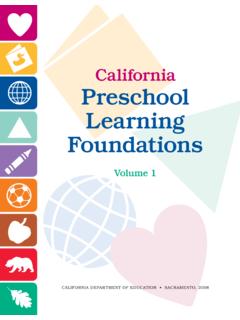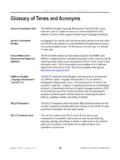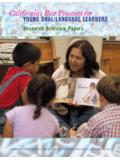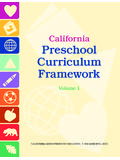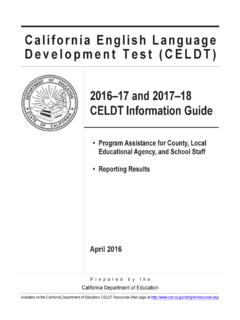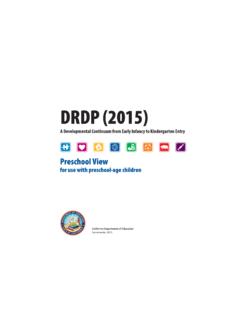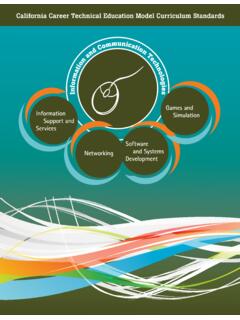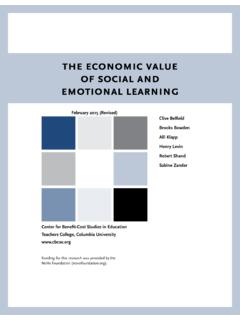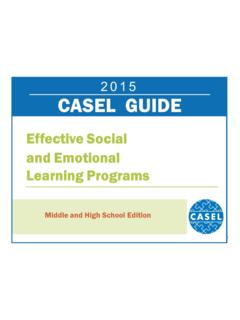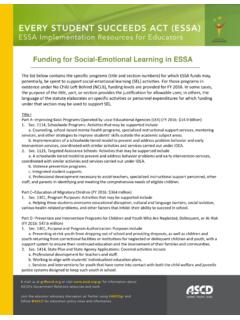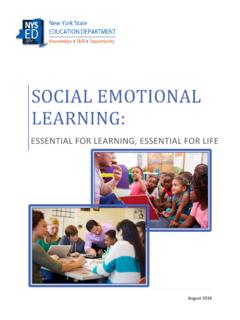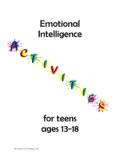Transcription of Guiding Principles Workbook - Social and …
1 California s Social and emotional learning Guiding Principles1 Adopt Whole Child Development as the Goal of Education2 Commit to Equity3 Build Capacity4 Partner with Families and Communities5 Learn and ImproveFOREWORDR epresentatives from more than 20 California education organizations and systems, in partnership with the California Department of Education, have come together to affirm Social and emotional learning as an essential part of a well-rounded, quality education in all youth-serving following Social and emotional (SEL) Guiding Principles ( Principles ) are intended to inform and support strong SEL practice across the state based on the collective experience of the contributors.
2 A robust body of research tells us that when evidence-based SEL programming is implemented well, academic achievement increases as does student well-being. 1 Those results not only persist over time and lead to better relationships and life outcomes for students across all socioeconomic and racial groups, but can also save our schools and society as much as $11 for every $1 invested. 2, 3A recent consensus statement by The Aspen Institute s National Commission on Social , emotional , and Academic Development s Council of Distinguished Scientists asserted that [i]ntegrating Social and emotional development with academic instruction is foundational to the success of our young people, and therefore to the success of our education system and society at large.
3 4 The integration of SEL to promote equity and address the needs of the whole child, and educators, is supported by many of our current policies, standards, funding and decision-making mechanisms, including Local Control and Accountability Plans (LCAP).As education leaders and their stakeholders are beginning or continuing integration of SEL in schools, districts, and youth-serving organizations, the Principles can be a resource in a variety of ways: in the development of LCAP goals; for roll out of the Multi-Tiered System of Support (MTSS); to set school or district leadership team priorities; to inform the design of professional learning , instructional approaches, and curricula adoption; in determining assessment methodologies and tools.
4 And, in the building of coalitions of families and community Principles should be refined to meet the unique needs of each community and can be used to measure progress toward shared Social and emotional learning goals. To model a learn and improve approach, CDE and partners plan to update the Principles as they are put to the test in the field and input is received from learning communities across the s Social and emotional learning Guiding Principles PAGE 2 INTRODUCTIONTo achieve the California Department of Education s mission and vision, our schools must support every child s unique journey to fulfill their potential by providing.
5 An equitable, culturally responsive education, academic, Social , and emotional learning , and safe, engaging, inclusive Collaborative for Academic, Social , and emotional learning (CASEL) defines Social and emotional learning as the process through which children and adults acquire and effectively apply the knowledge, attitudes, and skills necessary to understand and manage emotions, set and achieve positive goals, feel and show empathy for others, establish and maintain positive relationships, and make responsible decisions. Importantly, all learning is contextual and relationship- driven and SEL can serve as a lever to enhance equity, build positive climate and culture.
6 And foster a sense of belonging among all community following Guiding Principles are designed to build on the implicit and explicit SEL practices already happening in many schools and to promote the intentional use of evidence and research-based practices to guide Guiding Principles seek to empower local stakeholders to continue to advance SEL in ways that meet the needs of their specific contexts and Adopt Whole Child Development as the Goal of EducationTake a systems approach to promoting student academic, Social , and emotional learning , physical well-being, and college, career, and civic life readiness. 5 Name SEL as not a nice to have, but a must have to ensure student success in school, work, and Systems change:Embed and promote SEL across all education and youth development systems and structures,including but not limited to: vision statements, strategic plans, budgetary decisions, staffing,professional learning , school-wide policies, curricular adoption criteria, instructional practices, andinstructional quality assessments.
7 6B. Diverse and inclusive leadership teams:Systems change is most effectively driven by bringing together educator, student, family andcommunity member representatives of varied gender, racial, ethnic and socioeconomic Social and emotional skills development:Students and adults must have opportunities to practice, demonstrate, and reinforce Social andemotional skills within the context of supportive relationships. 8 Additionally, Social and emotionalskills instruction and integration into academic content areas contribute to a comprehensiveapproach. 9D. Student-centered discipline policies and practices:Discipline policies that are aligned with promoting Social and emotional growth, as opposed topunishment and exclusion, have been shown to yield the strongest student outcomes, while offeringthe opportunity to repair harm and build community.
8 10, 11, 12E. Climate and culture:SEL and school climate are interrelated and reciprocal. A positive school climate and culture can bedeveloped when community members are building strong Social and emotional skills. 13, 14 California s Social and emotional learning Guiding Principles PAGE 32 Commit to EquityAll students must have opportunities to build SEL skills and receive an assets-based educational experience that is personalized, culturally relevant and responsive, and intentionally addresses racism and implicit bias. Use practices that build on the existing strengths of students, educators, families, and communities. A. Address the opportunity gap:Opportunities to build SEL skills must be offered to all students and not be determined by race,ethnicity, national origin, religion, age, sex, sexual orientation, gender identity, disability, language,socioeconomic status, documentation status, and/or ZIP Ensure representation:When the educator workforce is representative of, and connected to, the student body, academic, Social , and emotional outcomes improve for students.
9 15, 16, 17C. Student and adult-led:SEL efforts are most effective when schools are participatory and engaging and diverse student voicesare included in decision-making and improvement efforts. 18, 19D. Healing-informed:Educational experiences must seek to counteract the institutional and structural biases and relatedtraumas that often drive inequitable outcomes for students. 203 Build CapacityBuild the capacity of both students and adults through an intentional focus on relationship-centered learning environments and by offering research-based learning experiences that cultivate core Social and emotional competencies. 21, relationships and belonging:To cultivate resilience to adversity and build the foundation for Social and emotional growth, ensureevery student and adult feels that they belong, have value, and have a network of caring peers to relyon.
10 23, 24, 25, and adult competenciesIdentify specific, research-based Social and emotional competencies to address, such as self-awareness, self-management, Social awareness, relationship skills and responsible-decision making,or related pro- Social mindsets and affective skills. Ensure common definitions of competencies areused. standards:To bring intentionality to practice, identify SEL teaching and learning standards or indicators that areresponsive to student strengths and needs. training and ongoing professional learning :Schools of education and ongoing professional learning should address student Social and emotionaldevelopment as well as personal growth strategies, including addressing bias, among those workingwith children, such as educators and other adult staff.

